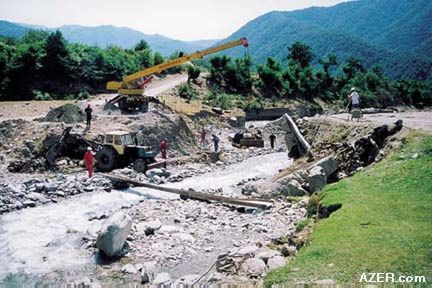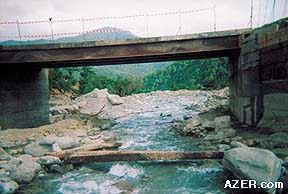|

Winter 2000 (8.4)
Pages
40-42
Bridging the Gaps
The Finns
Fascilitate Food Projects
The
idea, in its inception, was quite simple. Due to the collapse
of the Soviet Union and the repercussions that had resulted from
the Karabakh war, some of the members of the Greater Grace Church
in Baku, spearheaded by its pastor, Matti Sirvio, decided to
create a soup kitchen to prepare daily meals for some of the
city's neediest people. It started out on a small scale - a few
dozen people were fed each day, then 50, then sometimes as many
as 100.
As the project developed, its impact began to reach far beyond
Baku to a group of isolated villages in the Ismayilli region,
high up in the Caucasus mountains in north-central Azerbaijan.
In order to supply the soup kitchen with meat and produce, the
church involved the Finnish-Azerbaijani Society and decided to
provide cows and goats to the villagers and help them gear up
for agricultural projects for the following year. As payment,
the families would get to keep a portion of the produce - meat,
milk and cheese - and sustain the soup kitchen in Baku with the
rest.

Above: In cooperation with
the Finnish-Azerbaijan Society and local Azerbaijani villagers,
the Finnish company Aker Rauma Offshore brought in heavy construction
equipment used in the oil service industry to help rebuild a
bridge on the road that leads to Galajig, an isolated mountain
community in the Ismayilli region of the Caucasus mountains.
To the Society's surprise, there was a major hitch in this plan.
The only road into one of the villages crossed over a bridge
that was in a very precarious and dangerous condition. They expected
that it would be a simple job to repair it, but it turned out
to be a major reconstruction that needed cranes and equipment
to be brought in by the oil service company Aker Rauma. In the
end, the village was once again connected to the outside world.
This past September, we asked Ismo Haapala, Finnish Honorary
Consul and Business Development Manager of Aker Rauma, to tell
us how this seemingly small project on the part of Finland grew
to make such a significant contribution to Azerbaijan in two
separate regions of the country.
______
In 1993 and 1994, tens of thousands of Azerbaijani refugees poured
into Baku after fleeing their homes in Karabakh because of the
war with Armenia. Ismo Haapala had been working in Baku for a
few months at that time and remembers the sense of depression
and hopelessness that was in the air.
The elderly were particularly vulnerable, especially those who
didn't have relatives to take care of them. Since their pensions
were negligible, many of them were suffering from hunger.
  Left: The newly completed bridge to Galajig,
built by the Finnish-Azerbaijani society, with the help of local
community members and engineers from Aker Rauma Offshore. Now
villagers in Galajig can transport vegetable and milk produce
to Baku all year round. Left: The newly completed bridge to Galajig,
built by the Finnish-Azerbaijani society, with the help of local
community members and engineers from Aker Rauma Offshore. Now
villagers in Galajig can transport vegetable and milk produce
to Baku all year round.
Hannele
Haapala recalls that dismal time in the city's history: "We
started hearing reports that people were coming to hospitals
and dying-not from sickness but from hunger. It was shocking."
A Soup Kitchen
Members of the Greater Grace Church in Baku came up with the
idea to create a soup kitchen. Pastor Matti Sirvio helped to
get it organized. Then the group reached out to Helsinki's Finnish-Azerbaijani
Society to get it involved. Sirvio has since moved to Uzbekistan,
where, in addition to establishing another church ministry, he
has started a similar humanitarian soup kitchen project.
"When we started back in 1995, we rented a small place near
the Nariman Narimanov Metro Station," Hannele says. "The
blind, the poor, the retired came to get their food each day.
Some of them were invalids, so we started taking food directly
to their homes. We named the Kitchen 'Marhamat', which means
'Mercy' in Azeri. Mikayil Ahmadov helped start the project and
continues to be its Director."
The Society does more than just feed the hungry, she explains:
"There are also volunteers who visit homes and help with
other needs, such as cleaning, fixing lights and furniture and
whatever else needs to be done around the house. We want to help
the people who have a very hard life in Baku."

Above
(also bottom):
The Finnish-Azerbaijani Society, members of the local community
and engineers from Aker Rauma Offshore celebrate the completion
of the new bridge to Galajig.
As more and more people began to rely on the soup kitchen, the
Society decided to relocate it closer to Narimanbeyov Square.
Of course, they were running into financial difficulties all
the time. In 1999, the Society decided to seek assistance from
the Finnish government.
Far-Reaching Benefits
Even though this project was designed to help Baku residents,
its effects are being felt in a profound way in the countryside,
too. Now the soup kitchen contracts with five villages in the
Ismayilli region (Galajig, Ivanovka, Hajihatamli, Mujuhaftaran
and Galinchag), which is located about three hours northwest
of Baku.
"We're helping each village get started farming," Ismo
says. "The project owns the animals, and the villagers who
tend them get to keep part of the produce as their salary. This
enables the people to make a living without leaving their own
villages."
  Left: The
old bridge had nearly collapsed and every year during spring
floods when the snows melted off the mountains, the road became
impassable. Left: The
old bridge had nearly collapsed and every year during spring
floods when the snows melted off the mountains, the road became
impassable.
The Society first had in mind to structure the project somewhat
differently. "The original idea was to build a barn for
ten cows and hire people to take care of them," Hannele
recalls. "Then the milk, yogurt and cheese could be brought
to Baku.
"However, when we went to these villages, we saw the extreme
poverty that the people were living in. So instead of building
a barn for ten cows and having two or three people take care
of them, we ended up buying 15 cows and giving each family its
own.
"We now have 15 needy families being supported by these
cows. They had been too poor to be able to afford any livestock.
We bought the best cows so that they would produce lots of milk.
A highly productive cow costs between $200 and $300. Of course,
you can find cows for about $150, but they won't produce much
milk. We wanted each cow to give about 20 liters of milk per
day. This enables the family to live off two-thirds of the produce,
and the other one-third goes to the kitchen."
If the cows produce offspring, a similar formula comes into play.
Hannele believes this encourages the villagers to take good care
of the animals. "They know that having more animals will
increase their standard of living. If they take excellent care
of their single cow, then there's the possibility that it will
someday give birth to a calf. Then that's twice as much income
for the family."
Next year, the Society plans to provide the villagers with some
chickens. They didn't start this year because grain is expensive
for chicken feed, but by next year the villagers will be growing
their own grain.

Some of the villagers are even raising pigs. "We are experimenting
with ten pigs," Hannele explains. "Originally, we didn't
think about offering them, but people asked for them. If the
experiment goes well, we'll add more next year." During
the Soviet period, several districts in Azerbaijan catered to
Russians and Armenians and became famous for their hog-producing
farms despite the fact that Azerbaijan is traditionally a Muslim
country.
Making it Happen
One unexpected obstacle in this supply setup involved Galajig,
a remote mountainous village with a population of about 1,000
people. The only road - an extremely treacherous one - that connected
the village to the rest of Azerbaijan passed over an old, crumbling
concrete bridge. In early spring, when the snows from the Caucasus
melted and brought swollen river waters down through the valleys,
this bridge was usually impassable.
"Had we known at the very beginning that we'd end up having
to rebuild the bridge, we might not have tackled this project,"
admits Ismo. "But since we had already committed to the
villagers, we decided to push forward and include the bridge
repair as part of the project. We thought we could use the old
structure and do some repairs, but we ended up rebuilding the
entire bridge.
"When we investigated, we discovered that the foundation
of the bridge had been mostly washed away over the years because
of the rising waters. The concrete slabs were just propped up
on the gravel in the riverbed. There was nothing to secure them
and very little steel in the concrete slabs to reinforce them,"
he observes.
Finnish company Aker Rauma, which is involved in construction
as it relates to oil service projects, lent support by bringing
in the necessary cranes, generators and tools.
"Our Finnish engineers came up with the basic idea of how
to design the bridge," Ismo says, "but it was the local
people - 100 percent - who carried out the physical work. It
was very much a joint project."
The reconstruction took 17 days during late July and early August
of this year, when the river bed was at its lowest. "It's
probably the best-built bridge in all of Azerbaijan," he
says.
The bridge was constructed to be one meter higher than the original
bridge so that water can no longer wash over it as it has in
past years. The village is no longer cut off from the rest of
the country during the rainy season. Galajig is now producing
goats, potatoes and onions.
Flour Mill
Another obstacle turned up in the villages selected for growing
wheat. The problem was that there was no flour mill in these
villages, and the people were paying too much to transport their
wheat to the nearest mill. Once again, the Society came up with
a workable solution.
"We bought a second-hand mill in Finland and received another
one as a gift from a private donor," Ismo explains. "The
mills have the capacity to grind about 1.5 tons of flour a day.
We're waiting for the next major oil service shipment from Finland
to bring the mills here, as they can be brought in free of charge
as humanitarian cargo. Once we take them and set them up in the
villages, the people there will pay the same amount as they would
at other mills, but they'll save all their transportation costs.
Again, a portion of the money for grinding the flour will go
to support the soup kitchen. This is another way that we can
help the people in the village and support the soup kitchen at
the same time."
Food for the Future
Once the project is completely in place, the organizers hope
that it will be self-sustaining. "It should maintain itself,"
Ismo insists. "Once you've set this project up, you don't
need to pump it up with money all the time. After the first few
years, the villages will produce enough to support themselves
as well as the kitchen, year after year." They've added
a four-wheel-drive vehicle to the project to facilitate transporting
the produce to and from Baku.
This long-term perspective fits the Society's strategy of working
side by side with the Azerbaijani people to ensure that their
needs are met. "We didn't want to help in the usual way
- buying a container full of things, dumping it in the middle
of a village and then just disappearing," Ismo says. "Enabling
Azerbaijanis to care for themselves is a goal that is definitely
within reach. We're using everything we know about this country
and this region to make things happen."
____
From Azerbaijan
International
(8.4) Winter 2000.
© Azerbaijan International 2000. All rights reserved.
Back to Index
AI 8.4 (Winter 2000)
AI Home
| Magazine Choice | Topics
| Store
| Contact
us
|